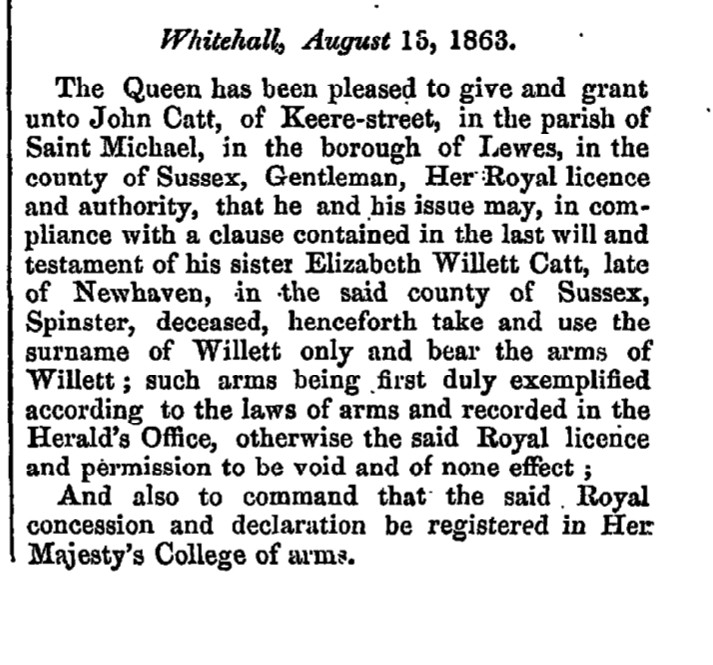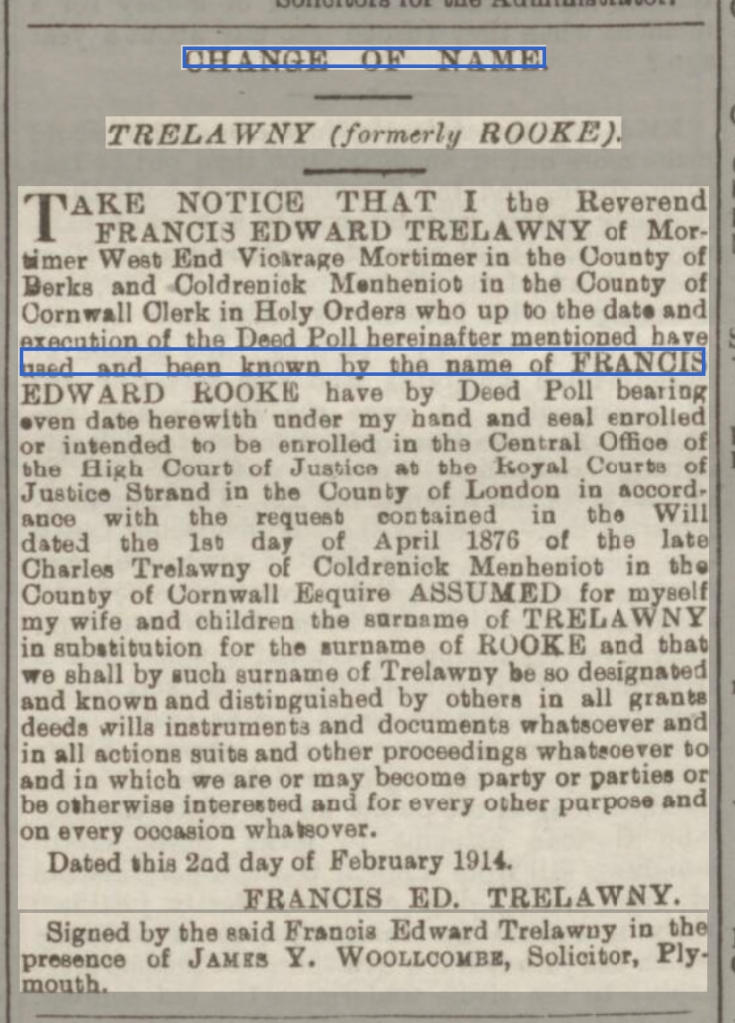Introduction
A person’s name is very much bound up with their identity and as a result, they can challenging to trace if it changes. In Part 1 of Chameleon Ancestors, I looked at some of the reasons why an ancestor might appear in the records under a different name. Many people, then as now, hated their first name, or preferred to use a middle name or pet name. An ancestor who was born illegitimately could have used a different name from the one recorded on their birth certificate. Transcription errors, deficiencies in the information recorded and errors made by the person who created the record may all explain why an ancestor is not found under the expected name. In this article, I will be looking at some additional reasons why people chose to use a different surname during their lifetime, particularly those who wanted to deliberately hide their identity and those who chose to change their name officially.
Maiden Name, Married Name, Partner’s Name
Women are often more difficult to trace in the records because of their change of surname upon marriage. In addition, it is not uncommon to find that a woman assumed the surname of a partner, despite there being no formal marriage. It added respectability and made any children from the relationship appear legitimate. This often happened after a marriage breakdown, as divorce was not easily obtainable for most people. Another option was for a woman to revert to using their maiden name. It may therefore be necessary to search under a number of possible surnames to identify women within different record sources.
Double Surnames
An additional surname might sometimes be added to commemorate a marriage, especially if the marriage had brought an inheritance (another area of research to investigate)! Some couples might even choose to have their names hyphenated together. In Welsh culture too, it has long been common to have two surnames because of the smaller pool of Welsh surnames. The researcher must therefore be aware that a plain Jones, for example, may, at a certain point, become a Lloyd-Jones. Nowadays, double-barrelled surnames have come into vogue, as more women are reluctant to give up their maiden name upon marriage. Occasionally, couples may choose a new name, created from the merging of both of their names.
Professional Names
If you have ancestors who were actors or actresses, writers, musicians or entertainers, you may discover that they used a stage name or a pseudonym. The real name of Michael Caine, for example, is Maurice Joseph Micklewhite. Mary Ann Evans, the author of the novel Middlemarch, wrote under the name George Eliot. These assumed names may be the ones that feature in records such as newspapers. The lifestyle of many performers, which often required a lot of moving around, adds to the challenge of locating them within records. Some individuals preferred to hide their real identity and covered up their background, (particularly if it was humble), using their professional names to obscure their origins. Conversely, perhaps an ancestor’s real name is known, but not their professional name. Knowledge of the name they assumed may be the key to unlocking information on their career. Some good resources on theatrical and performing ancestors can be found in Michelle Holman’s useful guide that appeared in Family Tree Magazine in February 2019: https://www.family-tree.co.uk/useful-genealogy-websites/top-resources-for-tracing-your-theatre-ancestors/

(Vienna International Film Festival 2012) https://en.wikipedia.org/wiki/Michael_Caine_filmography
Criminal Aliases
Criminals often found it expedient to change their name to escape justice. They are most likely to feature in court and prison records, convict transportation registers and newspaper reports. Helpfully, criminals may often be described with their original name along with their alias, if this was known:

Year Range: 1882-1906
Gloucestershire, England, Prison Records, 1728-1914
Returns of Habitual Criminals and Albums of Prisoners’ Photographs
The County Gaol 1882-1906 via http://www.ancestry.co.uk
Above are photographs of the prisoners, James Smith and James Allen, taken at Gloucester Gaol on two separate dates in February 1904. Clearly, both photographs feature the same person but what, (if either), is the man’s true name? Photographs were taken by the police because they helped to identify a suspect, even if they were using an alias.
Indeed, it should not be forgotten that many people deliberately wanted to disappear and purposely formed a new identity because they wanted to evade the law. For example, if their business had failed, a change of name could help them escape creditors. Others had unhappy personal relationships and to extricate themselves from their situation, it was often expedient for them to change their name. If a husband deserted his wife and/or children, for example, he could very well take on a new name to avoid being pursued for maintenance. If he married again without a divorce he could be charged with bigamy, so a new identity would also lessen the chance of this crime being uncovered. For family historians, individuals who wanted to leave their past behind often seem to vanish into thin air. Faced with this scenario, seek out other descendants who may have family information. In the absence of family information, the person’s new identity, and facts concerning the latter part of their life, may only be uncovered through the wonders of DNA testing.
Change of Name by Royal Licence and Act of Parliament
Historically, a change of name was often connected to the inheritance of property, when there were no direct male heirs. In these circumstances, the beneficiary could only inherit on condition that they took a particular name, usually the name of the deceased. This secured the property for the long-term benefit of the family. For the same reason, in some instances, a marriage settlement might also require a husband to adopt his wife’s name. Alternatively, the new surname could be added as a second surname.
Fortunately, a lot of official documentation was produced when a change of name was arranged due to the inheritance of property. It was important to go through the proper procedures and have a public record. In the 18th and 19th century, it was most common to officially change your name by royal licence. Since that also required a change to the coat of arms, applications for a royal licence from 1783 were either made through, or required a report from, the College of Arms. The arms could only be transferred to someone not in the legitimate male line of descent from the original grantee. Further information can be found on their website: https://www.college-of-arms.gov.uk/services/name-change. Incidentally, the College of Arms still offers a change of name service today, even if you are not entitled to arms.
An Act of Parliament was an alternative method of officially changing your name. Acts of Parliament are published in printed volumes arranged by year and can be consulted at the National Archives (U.K.) (https://www.nationalarchives.gov.uk/) and at other major libraries too. The Parliamentary Archives also holds some records: https://www.parliament.uk/
Both royal licences and Acts of Parliament required a lot of money so generally, only the wealthiest in society with substantial property to inherit would go to the lengths of obtaining one. Probate records and records of marriage settlements can provide evidence concerning why the change of name was sought.
Newspapers
A notice of a change of name may also have been published in a newspaper. The Times was a popular choice for an announcement and its archive is available online from 1785-1985: https://www.thetimes.co.uk/archive. The London/Edinburgh/Belfast Gazettes were also commonly used if an announcement was made. Fortunately, the combined records of all three Gazettes are available online and can be searched at: https://thegazette.co.uk/. It is also worth searching the British Newspaper Archive: https://britishnewspaperarchive.co.uk/ (also available on FindmyPast), for evidence of a change of name.
Here is a notice concerning the royal licence granted to John Catt, a gentleman of Lewes, which was posted in the London Gazette in 1863. He changed his name from Catt to Willett, according to the wishes expressed in the will of his late sister, Elizabeth Willett Catt:

Notice of a Royal Licence granted to John Catt of Lewes, Sussex, gentleman, to change his name to Willett and bear the arms of Willett
Probate records for the Catt and Willett families would certainly provide more information. Since the Willett family were armigerous, other sources such as the Heralds’ Visitations or Burkes Landed Gentry would be worth consulting. The College of Arms would also have information on the family’s grant of arms in their records.
Change of Name by Deed Poll
From the 20th century, the most common way of officially documenting a change of name is by deed poll, a legal contract involving only one party. A deed poll is made in the presence of a solicitor (formerly a Justice of the Peace or Commissioner for Oaths) and the document is then issued to the person. A further copy (uncertified) may be kept by the solicitor but it is unlikely to have survived. The person may then choose to announce their change of name in a newspaper: this is often the only way of discovering a previous name that has been changed by deed poll:

Reading Mercury dated Saturday February 7th 1914 via https://britishnewspaperarchive.co.uk/
The will of Charles Trelawny of Coldrenick Menheniot, Cornwall, was proved in 1883, the year of his death, so it would be interesting to discover why Francis Edward Rooke changed his name so many years later, in 1914.
Permanent Records of Deed Polls
To create a permanent record of the change of name, deeds could be lodged in the Enrolment Books of the Supreme Court (formerly the Close Rolls of Chancery until 1903). However, as this involved extra expenditure, most people did not bother to take this additional step. In fact, it has been estimated that only 1% of deed polls were enrolled so the chances of finding an enrolled deed poll are slim. Nevertheless, it is a possibility. The records have been deposited at the National Archives (U.K.)(https://www.nationalarchives.gov.uk/) and are indexed but not available online. However, records from 1945-2003 can be searched for free upon request. There are detailed instructions in the online research guide that will help you find a deed poll if it was enrolled between 1851-1903 or between 1904-1944.
Index to Sources Regarding Official Name Changes
If you think that a person might have changed their name officially prior to 1901, it can be worth consulting Phillimore and Fry’s An Index to Changes of Name for UK and Ireland 1760-1901. This name index provides references to the sources in which the change of name appears, which include:
- Private Acts of Parliament
- Royal licences published in the London and Dublin Gazettes
- Deed poll records
- Notices of changes of name published in The Times after 1861, with a few notices from other newspapers
- Registers of the Lord Lyon [King of Arms] where Scottish changes of name were commonly recorded
- Records in the office of the Ulster King at Arms (Ireland)
It does not include:
- Changes by royal licence not advertised in the London Gazette
- Changes by deed poll that were enrolled but not advertised in The Times
Foreign Nationals
Due to the fear of enemy aliens resident in Britain, foreign nationals were forbidden from changing their name in the First World War. No doubt this was to prevent spies, or those who were potentially a threat to national security, assuming a different name. The law came into being in 1916 and was not revoked until 1971. Exemptions were only given to women who took their husband’s name upon marriage, a person who had been granted a royal licence, or an individual who had been given special permission from the Home Secretary.
Second World War
There was a short period during the Second World War when British subjects could only change their name if they published a notice of the proposed change in the London Gazette, or the Edinburgh Gazette/Belfast Gazette (the Scottish and Irish equivalents), 21 days beforehand. This gave enough time for National Registration records to be amended and a ration book and identity card to be issued in the new name. The National Registration records were destroyed in 1952 but it could be worth searching the journals if you are looking for evidence of someone who disappears from the records around this time: https://thegazette.co.uk/
Conclusion
A change of name can cause many problems for genealogists. Perhaps you can document the early part of a person’s life but know nothing about their whereabouts later, or vice-versa. Problems can be exacerbated by an over-reliance on online search engines, where the name is the primary search criteria. If a person deliberately wanted a new life under a new name, perhaps to escape the law or family responsibilities, it can feel like looking for a needle in a haystack. In this scenario, seek out other descendants who may have family information. DNA testing can also provide some answers. One good strategy is to look for matches within different record sources. For example, if you have a candidate in the 1939 Register, a matching date of birth on a birth certificate could provide you with the proof that they are the person you are seeking, despite the name being different. Finding out as much as you can about the person’s wider family, their friends and their neighbours, is always a good strategy
Of course, there can be perfectly innocent reasons why someone would change their name, either officially or unofficially. Certainly not all people changing their name can be accused of subterfuge. Historically, many deliberate changes of name occurred because an inheritance was conditional upon assuming a new name. This official change of name is usually well documented. Probate records, marriage documents, and newspapers should all be consulted. Newspapers in particular are always worth searching, as announcing a change of name in the Press was the best way of making it public, if this was the intention. Records regarding the change of name might include deed polls, royal licences and Acts of Parliament. Determining the most likely reason why you can’t find someone in a record is always the best way of deciding which research strategy is likely to pay dividends.
© Judith Batchelor 2021
Thank you for this really helpful blog. I am interested in the John Catt story and wonder what lies behind this decision. Catt is a well known name in the Newhaven area and the parish church of Bishopstone on the outskirts of the town is full of Catts!
LikeLiked by 1 person
It is unusual in that it was his sister who insisted on the change of name from Catt to Willett. You can find the family in the census records in Lewes and there are lots of wills for them so I think it would make a really interesting study.
LikeLike
A thoroughly well researched piece, that will certainly help anyone who has an Ancestor who for one reason or another suddenly disappears of the radar!
LikeLiked by 1 person
Fantastic summary of the challenges we face when working with surnames…I know I have never found a marriage licence for my third-great-grandparents, Thomas Cox and Sarah Laxton. Plus, their children used Laxton in their name – when my 2nd great-grandmother, Sarah (Thomas and Sarah’s daughter), married – she signed her full name as Sarah Elizabeth Laxton Cox…Her sister, as witness, signed as Frances Charlotte Laxton Cox…
In the 1841 census, the elder Sarah’s name was recorded as Sarah Laxton. In 1851, it’s Sarah Cox, but she and Thomas no longer appear to live together. I’m fairly certain they lived what we would consider as “common-law”.
I love your posts 🙂
LikeLiked by 1 person
Thanks Teresa! It does sound as if Thomas and Sarah never married. Always the possibility that one of them was already married when they met.
LikeLike